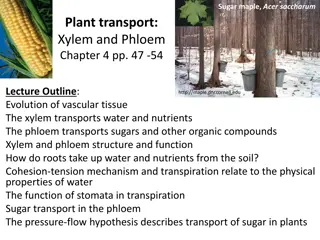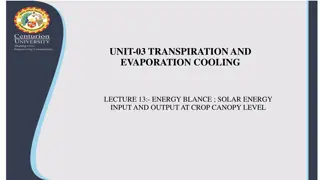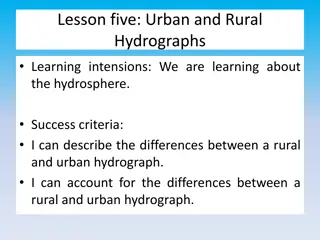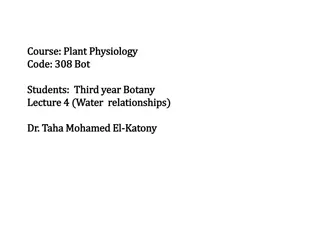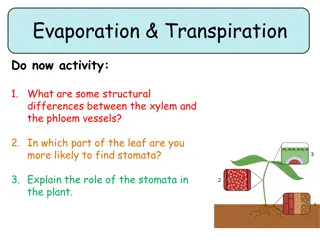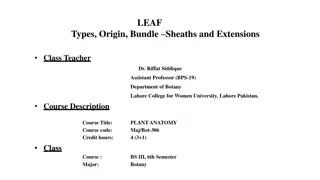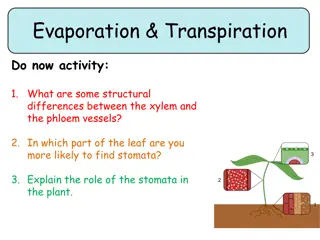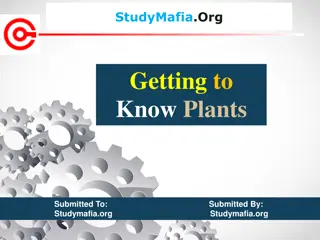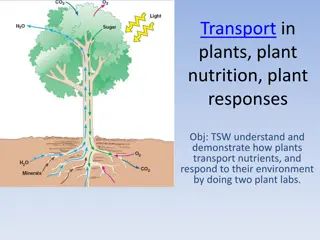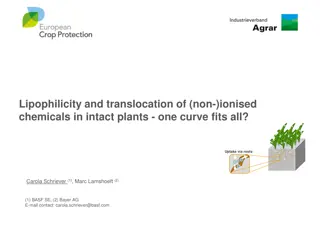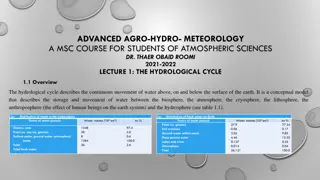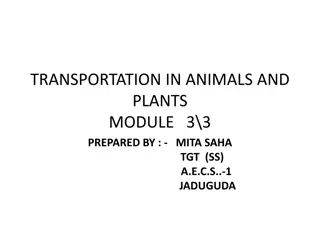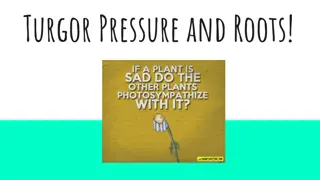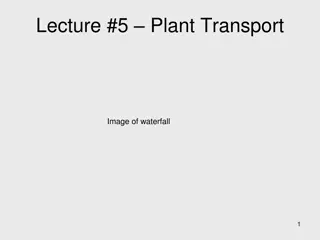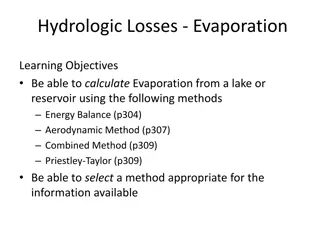Understanding Plant Transport Systems: Xylem and Phloem
Explore the intricate system of plant transport through xylem and phloem, from how roots absorb water to the pressure-flow hypothesis in sugar transport. Learn about the evolution, structure, and function of vascular tissues and the critical role of transpiration. Dive into the classification of pla
3 views • 27 slides
Solar Energy Balance in Crop Canopy: Understanding Input and Output
Solar energy plays a crucial role in the metabolic processes of plants, particularly in photosynthesis and transpiration. The input and output of solar energy at the canopy level impact the growth and productivity of crops, influenced by factors like leaf characteristics and plant density. Enhancing
3 views • 6 slides
Understanding the Water Cycle and Its Importance in Nature
Water is essential for all life on Earth, continuously moving through different physical states in a cycle that has been occurring for over 4 billion years. The Water Cycle involves processes like evaporation, transpiration, condensation, precipitation, and collection, ensuring water is always movin
11 views • 7 slides
Understanding Plant Transport Systems: Xylem, Phloem, and Transpiration
This comprehensive lecture outline delves into the intricate mechanisms of water and nutrient transport in plants. Topics covered include the roles of xylem and phloem, root water uptake processes, cohesion-tension mechanism, transpiration, stomatal function, sugar transport in phloem, and the press
4 views • 23 slides
Understanding Water Absorption in Plants: Mechanisms and Implications
Exploring the intricate process of water absorption in plants, this course delves into the active and passive methods used by roots to uptake water from soil, the role of osmosis in osmotic active absorption, the influence of transpiration on passive absorption, and the significance of root hairs in
1 views • 26 slides
Contrasting Urban and Rural Hydrographs
Hydrographs in urban and rural areas exhibit distinct characteristics due to differences in land use and infrastructure. Urban hydrographs typically display steeper rising and falling limbs, shorter lag times, and higher peak discharge rates compared to rural hydrographs, which have gentler slopes a
0 views • 14 slides
Understanding Water Relationships in Plant Physiology
Water plays a crucial role in the physiology of plants, with most absorbed water being translocated to leaves and lost through transpiration and guttation. While essential for turgidity and mineral translocation, plant water use is often inefficient. Transpiration is the primary mode of water loss,
3 views • 22 slides
Understanding Plant Evaporation and Transpiration Processes
Learn about the structural differences between xylem and phloem vessels, the role of stomata in plant leaves, and how water loss occurs through transpiration. Discover how guard cells regulate stomata openings and watch a video explaining transpiration processes in plants. Test your knowledge with s
0 views • 11 slides
Understanding Transpiration in Plants: Importance and Mechanisms
Transpiration is the process in which plants lose water vapor through their aerial parts, playing a crucial role in their overall functioning. This loss of water occurs mainly through stomata, lenticels, and the cuticle of leaves and stems. Different types of transpiration like stomatal, lenticular,
0 views • 19 slides
Understanding Transpiration and Gas Exchange in Plants
Transpiration is the evaporation of water from plants, mainly occurring through the leaves' stomata. Plants exchange gases like CO2 and O2 through various parts, without specialized organs. The process aids in photosynthesis, respiration, and cooling, demonstrating the importance of transpiration in
0 views • 22 slides
Understanding the Anatomy of a Leaf in Plant Biology
The anatomy of a leaf in plant biology is essential for understanding its structure and functions in photosynthesis and transpiration. This article explores the different parts of a leaf, including the leaf base, petiole, and lamina, as well as the types of leaves and venation patterns. By delving i
0 views • 29 slides
Understanding Transpiration Process in Plants
Explore the intricate process of transpiration in plants, focusing on the roles of stomata, guard cells, and water movement. Learn about the structural differences between xylem and phloem vessels, stomata's function in regulating gas exchange, and how environmental factors impact transpiration rate
0 views • 14 slides
Exploring the World of Plants: An Overview
Plants play a vital role in sustaining life on Earth by producing food and oxygen. This comprehensive guide delves into the diverse types of plants, such as herbs, shrubs, trees, creepers, and climbers. It also discusses the essential components of plants, like leaves, transpiration, and photosynthe
0 views • 20 slides
Understanding Plant Transport, Nutrition, and Responses
The process of how plants transport nutrients and respond to their environment is demonstrated through labs focusing on protein transport, water absorption by roots, and control of transpiration using mechanisms like diffusion, osmosis, and symbiotic relationships with fungi. Various components in p
0 views • 28 slides
Ecological Factors and Climatic Influences on Plant Life
Ecological factors play a crucial role in shaping the environment for organisms to thrive. This includes living (biotic) and non-living (abiotic) components like climatic factors, edaphic factors, topographic factors, and biotic factors. Climatic factors such as light, temperature, water, wind, and
0 views • 14 slides
Lipophilicity and Translocation of Chemicals in Plants: Exploring the Relationship Between Log.D and TSCF
A study investigates the correlation between the lipophilicity of chemicals and their translocation in intact plants. The focus is on the relationship between log.D values and the Transpiration Stream Concentration Factor (TSCF). Various curves are proposed to describe this relationship, aiming to r
0 views • 9 slides
Water Absorption by Plants: Mechanisms and Adaptation Strategies
Understanding water absorption by plants is crucial for effective water management in agriculture. Plants absorb water through active and passive methods, driven by osmotic and non-osmotic processes. Root hairs play a significant role in facilitating water uptake, with mechanisms such as osmotic act
0 views • 26 slides
Understanding Factors Affecting Transpiration in Plants
Factors influencing transpiration in plants include temperature, relative humidity, stomatal opening, and wind speed. These factors impact the rate of water loss through processes like evaporation and diffusion. Understanding how these factors affect transpiration can help in better plant care and c
0 views • 15 slides
Understanding the Hydrological Cycle in Advanced Agro-Hydro-Meteorology
The hydrological cycle involves the continuous movement of water on, above, and below the Earth's surface, encompassing various realms such as the biosphere, atmosphere, cryosphere, lithosphere, and hydrosphere. This cycle describes the storage and movement of water within different Earth systems an
0 views • 14 slides
Understanding Transportation in Animals and Plants Module
This module explores the transportation processes in plants, focusing on how water and nutrients are absorbed through roots, the role of root hairs, vascular tissue, xylem and phloem in transporting substances, and the important process of transpiration in cooling and water release. It highlights th
0 views • 8 slides
Understanding Abiotic Cycles in Ecosystems: Hydrologic, Carbon, Nitrogen, and More
Abiotic cycles play a crucial role in regulating ecosystems. The hydrologic cycle involves processes like evaporation, condensation, precipitation, and transpiration. The carbon cycle relies on photosynthesis, respiration, and human activities like deforestation and burning fossil fuels. The nitroge
0 views • 20 slides
Understanding the Water Cycle: An Explanation Text
The explanation text discusses the water cycle, also known as the hydrological cycle, detailing the stages of evaporation, condensation, precipitation, and transpiration. It explains how water molecules transform from liquid to vapor and back due to the sun's heat and gravity. The importance of wate
0 views • 7 slides
Fascinating Insights into Plant Physiology and Water Transport Mechanisms
Delve into the intricate world of plant biology with discussions on osmosis, diffusion, active transport, root pressure, transpiration, cohesion, adhesion, and turgor pressure. Explore how water and nutrients are absorbed by roots, transported through xylem to the leaves, and how sugars are produced
0 views • 14 slides
Understanding Plant Water Transport Mechanisms
Explore the intricate process of water movement in plants through essential concepts such as water potential, transpiration, and the pressure flow model. Discover why water is crucial for plant metabolism, nutrient uptake, and gas exchange, as illustrated in captivating diagrams. Learn how water pot
0 views • 134 slides
Understanding Evaporation Methods and Implications in Hydrology
Learn how to calculate evaporation using various methods such as Energy Balance, Aerodynamic Method, Combined Method, and Priestley-Taylor. Understand the importance of evaporation and transpiration in the hydrological cycle, climate change predictions, and water availability for ecosystems and agri
0 views • 10 slides
Understanding Water Losses and Evaporation in Hydrology
The hydrological equation explains the various factors contributing to water losses, including interception by vegetation, evaporation from water and soil surfaces, transpiration, evapotranspiration, infiltration into soil, and watershed leakage. Evaporation is influenced by temperature, humidity, w
0 views • 20 slides
